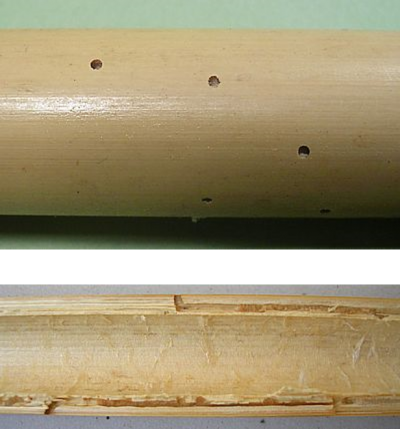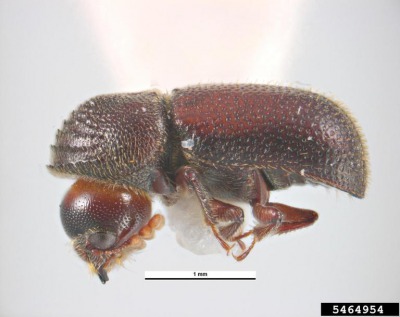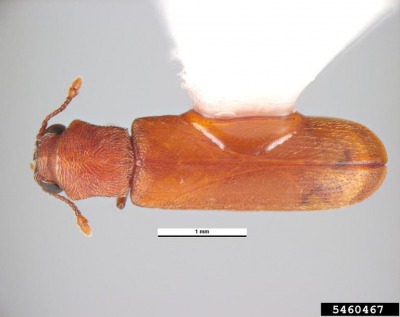- Knowledge Overview
-
Insect/pest damage is considered one of the “three evils of bamboo” along with mold and cracking. Insect repellent technology for bamboo materials has been explored as an important technique for extending the life and improving the quality of bamboo products. In Japanese culture, where bamboo has been used in various aspects of daily life since ancient times, knowledge related to insect repellent measures has been utilized in the preservation of cultural assets, and research in both industrial and cultural fields has been conducted.
In Japan, bamboo has been cut down at times of the year when it is less likely to attract insects, and lacquer coating has been used as a measure to prevent insect infestation, and today, applying and dipping chemicals is also practiced. As the use of chemicals has become less common due to increasing safety and environmental concerns, alternative measures such as carbonization technology using high-temperature, high-pressure steam treatment have been developed and their effectiveness is being verified. This knowledge explanation is intended for knowledge that has been introduced at production sites in the bamboo industry.
- Background (history and development)
-
Bamboo in Japan grow throughout the country and are classified into 131 groups, including madake (Phyllostachys), moso bamboo, hachiku, and chishimazasa (Sasa kurilensis). Within these, useful species are used in agriculture, fishing, and as tools for daily lives. Rantaishikki: urushi lacquer ware made by bamboo (containers made of woven net-like bamboo coated with lacquer) was unearthed at the Korekawa Ruins in Aomori Prefecture from early Jomon era’s ruins, indicating that the history of using bamboo goes back at least several thousand years. Some of the knowledge related to insect/pest control has been cultivated and passed down over such a long history. Lacquer coating is one of them. Some of them are difficult to verify scientifically, such as new moon logging (harvesting around new moon period to prevent insects and rotting). In the modern era, while science-based methods are being introduced and research and development is being conducted, it seems that the time for cutting bamboo is also being selected based on folklore.

Figure 1. Insect/Pest feeding damage (top: small holes are adult insect escape holes; bottom: internal feeding scars) - How to Apply Knowledge
-
In Japan, the major pests that cause damage to bamboo include dinoderus minutus, dinoderus japonicus, lyctus brunnus, lyctoxylon dentatum, and the diocalandra sasa. Dinoderus minutus (Figure 2) and lyctus brunnus (Figure 3), which are the most damaging of these insects, are both southern insects and are also distributed in Southeast Asia. For dinoderus minutus, both larvae and adult insects cause feeding damage. Therefore, the amount of damage is greater than lyctus brunnus, which only the larvae cause feeding damage. Other feeding damage by larvae is also observed when adults of chlorophorus annularis and purpuricenus temminckii lay eggs on bamboo.

Figure 2. Dinoderus minutus (M.O’Donnell and A.Cline, Wood Boring Beetle Families, USDA APHIS PPQ, photo by Bugwood.org)

Figure 3. Lyctus brunnus (Pest and Diseases Image Library, photo by Bugwood.org) Research related to insect repellent technology has been conducted to verify the effectiveness for each type of pest. A technique that is effective against one type of insect can often be applied to other types, and for practical purposes, the technology can be considered effective for all of the above-mentioned pests.
When to harvest bamboo
Since the pests feed on sugars in the interior of bamboo, bamboo wood with high sugar and starch content is more susceptible to insect damage. In spring and summer, when bamboo shoots grow, it is more likely for the bamboo to attract insects because of its high sugar and starch content, while bamboo harvested in fall and winter is recommended as less likely to attract insects. The specific timing varies from region to region and is chosen empirically by the bamboo collectors. In reality, it is difficult to maintain a livelihood by cutting bamboo only in the fall and winter. This is why it is necessary to cut down bamboo throughout the year, and produce bamboo materials and products that last longer, while also using insect repellent technology.
Furthermore, there is a tradition that bamboo cut down during the new moon of the eighth month of the lunar calendar (modern September) is less likely to attract insects and lasts longer. Such traditions like harvesting around new moon period also exist in timber harvesting, and similar tradition can be found around the world, but science has found no correlation between the movement of the moon and the amount of insect damage.
Bamboo Processing
Pests feed on the sugar inside bamboo, so when using bamboo skin for braiding, it is considered effective to process the bamboo material into bamboo strips immediately after obtaining it and separate the skin from the body. Oil removal is also effective in insect control because it removes sugars from the inside of the bamboo.
Chemical treatment
In Japan, the application and dipping of chemicals such as chlordane or chloronaphthalene was mainly used. Currently, due to stricter safety standards, the concentration of such chemical agents is regulated or their use is prohibited. Therefore, chemicals with low environmental impact and no legal problems are on the market, and are used for both antiseptic and antifungal purposes. Since the coating-dipping method has limited duration of insect repellent effect, a method has been developed to penetrate the chemical into the interior of the bamboo using a vacuum-pressurized injector to maintain the insect repellent effect for a longer period.
In Japan, the protective agents that can be used on wood materials are examined by the Japan Wood Preservation Association, and only certified agents are used, and the treated wood is standardized under the Japanese Agricultural Standards (JAS) and Japanese Industrial Standards (JIS). The chemical is used mainly in building materials, bamboo fences, and bamboo stakes, and less frequently in tableware and sundries.
Heat treatment
Carbonization process is attracting attention as an alternative technology to chemicals. This is a method of pretreating bamboo with high-temperature, high-pressure steam using a special kiln. Although the Oita Industrial Research Institute has verified the effectiveness of the chemical and found a certain level of insect control, further technological development is needed to achieve the same level of effectiveness as the chemical.
Acetylation treatment is another method of preventing wood deterioration. Acetylation is a chemical reaction of wood and acetic anhydride under high temperature and pressure, which increases the hydrophobicity (water repelling property) of the wood and improves its durability and weather resistance. Acetylation was also tested on bamboo wood and was found to be effective against the feeding damage caused by the dinoderus minutus.
- Examples of Applying Knowledge
-
The wood of bamboo culms (culm is the part of the stem) contains high levels of sugars and starch, and is susceptible to damage by mold and insect pests. Proper use of insect repellent technology can increase the durability of bamboo products.
Japanese knowledge is often used for products such as bamboo baskets and bamboo fences. On the other hand, in developing countries in the tropics, bamboo is widely used as a building material and scaffolding for construction work, so it cannot be used to prevent decay, which would reduce its strength.
Looking at the actual examples in this knowledge, it is important not to use young bamboo, which contains a lot of sugar and starch, and a simple method to protect of insects and fungi is to first soak the bamboo in water. Immediately soak the felled bamboo in water (using running water or changing the water occasionally), taking care to prevent mold from forming, and soak for about a month, then dry thoroughly. This process washes out the sugars with water to prevent insects from attaching. Sometimes a saline solution is used as well. Also, a method of soaking in borate solution (Borax, etc.) is often used as a highly safe inorganic agent. Other traditional methods include smoke fumigation, which has also been used for a long time. As for chemical treatment methods, wood preservatives and insect repellents are also used for bamboo, but highly toxic products are currently prohibited. Recently, environmentally friendly methods have been explored, including the use of neem extracts and various bio-oils derived from plants. However, these methods are often only tested at the laboratory level, and few have been put into practical use.
In Asian countries, bamboo products are expected to be candidates for forest-related business. Bamboo grows quickly and takes only a short time to be converted into cash, making it easy for participating residents to realize the benefits of the business. On the other hand, the quality of bamboo products in developing countries is generally low, creating a barrier to entry into high-priced markets such as those for wealthy domestic consumers, foreign tourists, and exports overseas. As for insect control technology, each developing country and regions may have its own traditional methods, but there are prospects that they can be further strengthened by referring to Japanese technology. If longer-lasting, higher-quality products can be produced, bamboo products can be expected to grow as a more profitable forestry business in developing countries.
Since there are many types of bamboo, and because the climate and major pests differ from region to region, it is necessary to consider methods tailored to local conditions when applying insect repellent technology to different countries and regions. For technologies that require materials such as chemicals and machinery, the availability of materials should be confirmed in advance.
- Positioning and Characteristics of Knowledge in Japan
-
Insect repellent technology are thought to have been explored for a long time in many parts of the world where bamboo is used. In Japan, traditional methods include choosing when to harvest bamboo. Since the 1970s, the Forestry and Forest Products Research Institute and other public experimental and research institutes have developed insect repellent technologies. Nowadays, the increasing safety and environmental consciousness of the public, demands the development of alternative technologies to chemical treatment. In the midst of such changes in the social background, there is a tendency to accept insect damage as a characteristic of natural materials.
- Owners/inheritors of knowledge
-
Insect repellent technology has been researched and developed by public experimental and research institutes in regions where the bamboo and wood industries are thriving, such as the Forestry and Forest Products Research Institute, Oita Industrial Research Institute, Kagoshima Prefectural Institute of Industrial Technology, and the Forest Products Research Institute, Forest Research Department, Hokkaido Research Organization.
- Other
-
Bamboo products grow faster than wood and can be converted into cash in a shorter period of time, so they are a material that is compatible with the participatory forest management systems promoted in various countries as part of forest conservation policies.
Your Knowledge could start making a change, when issue is faced; in forest conservation, or in value chains to use forest resources in a sustainable way.


Your Feedback.